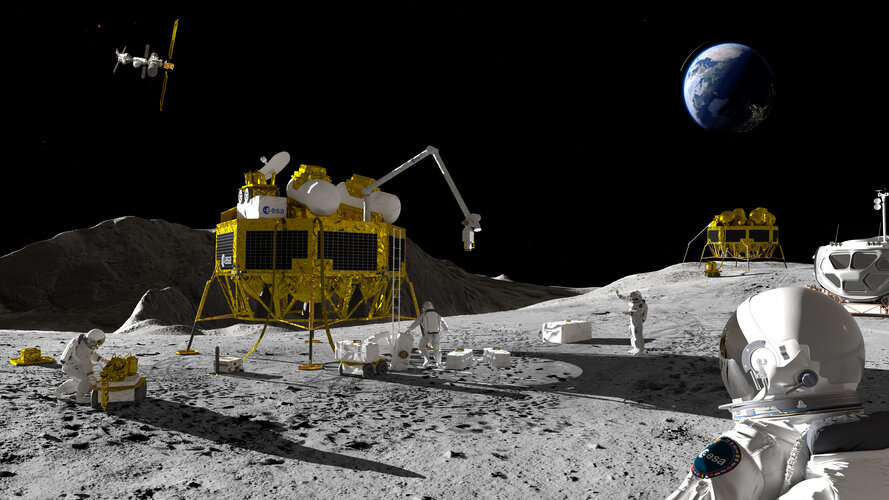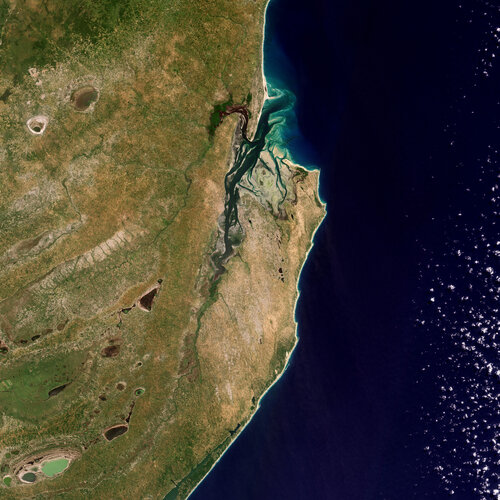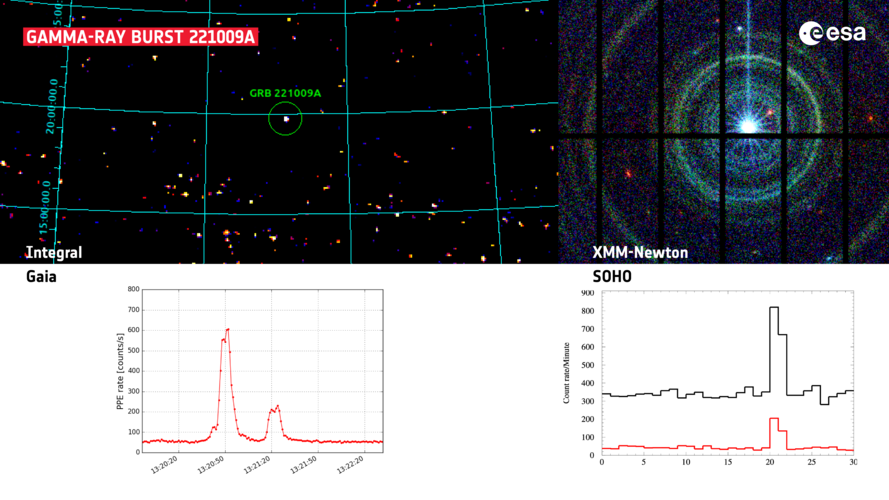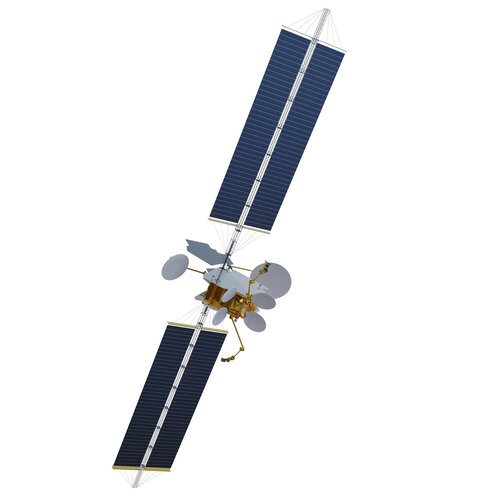Virgin Orbit and Luxembourg sign agreement to advance allied responsive space capabilities across Europe
Friday, 21 October 2022 08:50
Luxembourg (SPX) Oct 19, 2022
 Virgin Orbit (Nasdaq: VORB) and the Luxembourg Minister of Defence has signed a Letter of Intent that will begin the process towards developing responsive space capabilities inclusive of mobile launch infrastructure that would be based in Luxembourg, but available for NATO partners, and other Allies across the European continent. As part of the agreement, Virgin Orbit, in close coordination with
Virgin Orbit (Nasdaq: VORB) and the Luxembourg Minister of Defence has signed a Letter of Intent that will begin the process towards developing responsive space capabilities inclusive of mobile launch infrastructure that would be based in Luxembourg, but available for NATO partners, and other Allies across the European continent. As part of the agreement, Virgin Orbit, in close coordination with
 Virgin Orbit (Nasdaq: VORB) and the Luxembourg Minister of Defence has signed a Letter of Intent that will begin the process towards developing responsive space capabilities inclusive of mobile launch infrastructure that would be based in Luxembourg, but available for NATO partners, and other Allies across the European continent. As part of the agreement, Virgin Orbit, in close coordination with
Virgin Orbit (Nasdaq: VORB) and the Luxembourg Minister of Defence has signed a Letter of Intent that will begin the process towards developing responsive space capabilities inclusive of mobile launch infrastructure that would be based in Luxembourg, but available for NATO partners, and other Allies across the European continent. As part of the agreement, Virgin Orbit, in close coordination with NASA readies Superstack for upcoming JPSS-2 launch
Friday, 21 October 2022 08:50
Greenbelt MD (SPX) Oct 20, 2022
 Two very different payloads flying on one rocket are ready for their ride to space. Creating an integrated stack that stands 25 feet tall, the National Oceanic and Atmospheric Administration's (NOAA) Joint Polar Satellite System-2 (JPSS-2) and NASA's Low-Earth Orbit Flight Test of an Inflatable Decelerator (LOFTID) spacecraft are safely secured inside the United Launch Alliance (ULA) Atlas V roc
Two very different payloads flying on one rocket are ready for their ride to space. Creating an integrated stack that stands 25 feet tall, the National Oceanic and Atmospheric Administration's (NOAA) Joint Polar Satellite System-2 (JPSS-2) and NASA's Low-Earth Orbit Flight Test of an Inflatable Decelerator (LOFTID) spacecraft are safely secured inside the United Launch Alliance (ULA) Atlas V roc
 Two very different payloads flying on one rocket are ready for their ride to space. Creating an integrated stack that stands 25 feet tall, the National Oceanic and Atmospheric Administration's (NOAA) Joint Polar Satellite System-2 (JPSS-2) and NASA's Low-Earth Orbit Flight Test of an Inflatable Decelerator (LOFTID) spacecraft are safely secured inside the United Launch Alliance (ULA) Atlas V roc
Two very different payloads flying on one rocket are ready for their ride to space. Creating an integrated stack that stands 25 feet tall, the National Oceanic and Atmospheric Administration's (NOAA) Joint Polar Satellite System-2 (JPSS-2) and NASA's Low-Earth Orbit Flight Test of an Inflatable Decelerator (LOFTID) spacecraft are safely secured inside the United Launch Alliance (ULA) Atlas V roc NGC delivers first GEM 63XL solid rocket boosters to support Vulcan first flight
Friday, 21 October 2022 08:50
Magna UT (SPX) Oct 20, 2022
 Northrop Grumman has delivered the first two 63-inch-diameter extended length Graphite Epoxy Motors (GEM 63XL) to Cape Canaveral Space Force Station, Florida.
The solid rocket boosters will support the inaugural flight of United Launch Alliance's (ULA) Vulcan Centaur rocket planned for first quarter 2023. At approximately 72-feet-long, and weighing over 117,000 pounds, the GEM 63XL is the
Northrop Grumman has delivered the first two 63-inch-diameter extended length Graphite Epoxy Motors (GEM 63XL) to Cape Canaveral Space Force Station, Florida.
The solid rocket boosters will support the inaugural flight of United Launch Alliance's (ULA) Vulcan Centaur rocket planned for first quarter 2023. At approximately 72-feet-long, and weighing over 117,000 pounds, the GEM 63XL is the
 Northrop Grumman has delivered the first two 63-inch-diameter extended length Graphite Epoxy Motors (GEM 63XL) to Cape Canaveral Space Force Station, Florida.
The solid rocket boosters will support the inaugural flight of United Launch Alliance's (ULA) Vulcan Centaur rocket planned for first quarter 2023. At approximately 72-feet-long, and weighing over 117,000 pounds, the GEM 63XL is the
Northrop Grumman has delivered the first two 63-inch-diameter extended length Graphite Epoxy Motors (GEM 63XL) to Cape Canaveral Space Force Station, Florida.
The solid rocket boosters will support the inaugural flight of United Launch Alliance's (ULA) Vulcan Centaur rocket planned for first quarter 2023. At approximately 72-feet-long, and weighing over 117,000 pounds, the GEM 63XL is the New Site, New Sights, New Science: Sols 3628-3629
Friday, 21 October 2022 08:50
Pasadena CA (JPL) Oct 20, 2022
 For the first time in a little while we're at a new location after a drive in the last plan, which means new targets for the Geo team to investigate, and slightly different viewsheds for ENV to work with. Power was a bit tight, especially for the first sol with two hours of science time, a drive, and arm activities. Still, we managed to pack in lots of targeted science before driving away.
For the first time in a little while we're at a new location after a drive in the last plan, which means new targets for the Geo team to investigate, and slightly different viewsheds for ENV to work with. Power was a bit tight, especially for the first sol with two hours of science time, a drive, and arm activities. Still, we managed to pack in lots of targeted science before driving away.
 For the first time in a little while we're at a new location after a drive in the last plan, which means new targets for the Geo team to investigate, and slightly different viewsheds for ENV to work with. Power was a bit tight, especially for the first sol with two hours of science time, a drive, and arm activities. Still, we managed to pack in lots of targeted science before driving away.
For the first time in a little while we're at a new location after a drive in the last plan, which means new targets for the Geo team to investigate, and slightly different viewsheds for ENV to work with. Power was a bit tight, especially for the first sol with two hours of science time, a drive, and arm activities. Still, we managed to pack in lots of targeted science before driving away. Arecibo Observatory-led Team discovers large near-earth asteroid has changing rotation
Friday, 21 October 2022 08:50
Orlando FL (SPX) Oct 20, 2022
 Ateam of scientists led by Arecibo Observatory and the University of Central Florida has measured a change in the rotation period of the potentially hazardous near-Earth asteroid 3200 Phaethon, a future spacecraft target.
Phaethon is just the 11th asteroid with a measured change in its rotation period, and it is the largest of them.
The discovery is an example of progress in global e
Ateam of scientists led by Arecibo Observatory and the University of Central Florida has measured a change in the rotation period of the potentially hazardous near-Earth asteroid 3200 Phaethon, a future spacecraft target.
Phaethon is just the 11th asteroid with a measured change in its rotation period, and it is the largest of them.
The discovery is an example of progress in global e
 Ateam of scientists led by Arecibo Observatory and the University of Central Florida has measured a change in the rotation period of the potentially hazardous near-Earth asteroid 3200 Phaethon, a future spacecraft target.
Phaethon is just the 11th asteroid with a measured change in its rotation period, and it is the largest of them.
The discovery is an example of progress in global e
Ateam of scientists led by Arecibo Observatory and the University of Central Florida has measured a change in the rotation period of the potentially hazardous near-Earth asteroid 3200 Phaethon, a future spacecraft target.
Phaethon is just the 11th asteroid with a measured change in its rotation period, and it is the largest of them.
The discovery is an example of progress in global e To explore space means defying dust
Friday, 21 October 2022 07:02
As the world’s space agencies prepare to return to the Moon and explore the planets, space materials engineers have been getting to grips with a challenging enemy: dust. The abrasive, talcum-like dust enshrouding the Moon and other planetary surfaces can obscure surfaces, wear away at coatings and clog space mechanisms.
Earth from Space: Inhambane Bay, Mozambique
Friday, 21 October 2022 07:00
Inhambane Bay, in southeast Mozambique, is featured in this true-colour image captured by the Copernicus Sentinel-2 mission.
ESA spacecraft catch the brightest ever gamma-ray burst
Friday, 21 October 2022 06:30 Image:
ESA spacecraft catch the brightest ever gamma-ray burst
Image:
ESA spacecraft catch the brightest ever gamma-ray burst Reprogrammable OneSat on track for success
Friday, 21 October 2022 06:14
The OneSat family of geostationary software-defined telecommunications satellites has passed successfully its first qualification review.
Sidus Space executes launch agreement with Vaya Space
Friday, 21 October 2022 05:15
Cape Canaveral FL (SPX) Oct 21, 2022
 Sidus Space, Inc. (NASDAQ:SIDU), a Space-as-a-Service company, focused on mission critical hardware manufacturing combined with commercial satellite design, manufacture, launch, and data collection, has signed a launch agreement with Vaya Space for four launches over multiple years. Vaya Space is an emerging leader in sustainable space access and this agreement expands Sidus Space's ability to d
Sidus Space, Inc. (NASDAQ:SIDU), a Space-as-a-Service company, focused on mission critical hardware manufacturing combined with commercial satellite design, manufacture, launch, and data collection, has signed a launch agreement with Vaya Space for four launches over multiple years. Vaya Space is an emerging leader in sustainable space access and this agreement expands Sidus Space's ability to d
 Sidus Space, Inc. (NASDAQ:SIDU), a Space-as-a-Service company, focused on mission critical hardware manufacturing combined with commercial satellite design, manufacture, launch, and data collection, has signed a launch agreement with Vaya Space for four launches over multiple years. Vaya Space is an emerging leader in sustainable space access and this agreement expands Sidus Space's ability to d
Sidus Space, Inc. (NASDAQ:SIDU), a Space-as-a-Service company, focused on mission critical hardware manufacturing combined with commercial satellite design, manufacture, launch, and data collection, has signed a launch agreement with Vaya Space for four launches over multiple years. Vaya Space is an emerging leader in sustainable space access and this agreement expands Sidus Space's ability to d NASA orders three more Orion spacecraft from Lockheed Martin
Friday, 21 October 2022 05:15
Denver CO (SPX) Oct 21, 2022
 Lockheed Martin (NYSE: LMT) is now under contract to deliver three Orion spacecraft to NASA for its Artemis VI-VIII missions, continuing the delivery of exploration vehicles to the agency to carry astronauts into deep space and around the Moon supporting the Artemis program.
Lockheed Martin is the prime contractor to NASA for the Orion program and has completed two Orion vehicles-EFT-1 whi
Lockheed Martin (NYSE: LMT) is now under contract to deliver three Orion spacecraft to NASA for its Artemis VI-VIII missions, continuing the delivery of exploration vehicles to the agency to carry astronauts into deep space and around the Moon supporting the Artemis program.
Lockheed Martin is the prime contractor to NASA for the Orion program and has completed two Orion vehicles-EFT-1 whi
 Lockheed Martin (NYSE: LMT) is now under contract to deliver three Orion spacecraft to NASA for its Artemis VI-VIII missions, continuing the delivery of exploration vehicles to the agency to carry astronauts into deep space and around the Moon supporting the Artemis program.
Lockheed Martin is the prime contractor to NASA for the Orion program and has completed two Orion vehicles-EFT-1 whi
Lockheed Martin (NYSE: LMT) is now under contract to deliver three Orion spacecraft to NASA for its Artemis VI-VIII missions, continuing the delivery of exploration vehicles to the agency to carry astronauts into deep space and around the Moon supporting the Artemis program.
Lockheed Martin is the prime contractor to NASA for the Orion program and has completed two Orion vehicles-EFT-1 whi Celebrating Halloween and investigating ghoulish rocks from the Red Planet
Friday, 21 October 2022 05:15
Pasadena CA (JPL) Oct 21, 2022
 Have you ever seen faces on Mars? What about weirdly shaped rocks resembling animals and bones? Rocks with spooky holes and crevices?
Over the course of Perseverance's time on Mars, multiple images captured by the Mastcam-Z instrument aboard the Rover have garnered special attention from the wider public. A recent example of this involved a Mastcam-Z image acquired on June 12, 2022 (Sol 46
Have you ever seen faces on Mars? What about weirdly shaped rocks resembling animals and bones? Rocks with spooky holes and crevices?
Over the course of Perseverance's time on Mars, multiple images captured by the Mastcam-Z instrument aboard the Rover have garnered special attention from the wider public. A recent example of this involved a Mastcam-Z image acquired on June 12, 2022 (Sol 46
 Have you ever seen faces on Mars? What about weirdly shaped rocks resembling animals and bones? Rocks with spooky holes and crevices?
Over the course of Perseverance's time on Mars, multiple images captured by the Mastcam-Z instrument aboard the Rover have garnered special attention from the wider public. A recent example of this involved a Mastcam-Z image acquired on June 12, 2022 (Sol 46
Have you ever seen faces on Mars? What about weirdly shaped rocks resembling animals and bones? Rocks with spooky holes and crevices?
Over the course of Perseverance's time on Mars, multiple images captured by the Mastcam-Z instrument aboard the Rover have garnered special attention from the wider public. A recent example of this involved a Mastcam-Z image acquired on June 12, 2022 (Sol 46 A hydrogen-rich first atmosphere for Mars inferred from clays on its surface
Friday, 21 October 2022 05:15
Tempe AZ (SPX) Oct 21, 2022
 According to new research, Mars may have been born a blue and water-covered world, long before the Earth had even finished forming. The discovery could open a window for scientists on an overlooked chapter in Martian history.
In a recent study published in Earth and Planetary Science Letters, a team of researchers, including several from Arizona State University, found that Mars's earliest
According to new research, Mars may have been born a blue and water-covered world, long before the Earth had even finished forming. The discovery could open a window for scientists on an overlooked chapter in Martian history.
In a recent study published in Earth and Planetary Science Letters, a team of researchers, including several from Arizona State University, found that Mars's earliest
 According to new research, Mars may have been born a blue and water-covered world, long before the Earth had even finished forming. The discovery could open a window for scientists on an overlooked chapter in Martian history.
In a recent study published in Earth and Planetary Science Letters, a team of researchers, including several from Arizona State University, found that Mars's earliest
According to new research, Mars may have been born a blue and water-covered world, long before the Earth had even finished forming. The discovery could open a window for scientists on an overlooked chapter in Martian history.
In a recent study published in Earth and Planetary Science Letters, a team of researchers, including several from Arizona State University, found that Mars's earliest Why NASA is trying to crash land on Mars
Friday, 21 October 2022 05:15
Pasadena CA (JPL) Oct 21, 2022
 Like a car's crumple zone, the experimental SHIELD lander is designed to absorb a hard impact.
NASA has successfully touched down on Mars nine times, relying on cutting-edge parachutes, massive airbags, and jetpacks to set spacecraft safely on the surface. Now engineers are testing whether or not the easiest way to get to the Martian surface is to crash.
Rather than slow a spacecraft
Like a car's crumple zone, the experimental SHIELD lander is designed to absorb a hard impact.
NASA has successfully touched down on Mars nine times, relying on cutting-edge parachutes, massive airbags, and jetpacks to set spacecraft safely on the surface. Now engineers are testing whether or not the easiest way to get to the Martian surface is to crash.
Rather than slow a spacecraft
 Like a car's crumple zone, the experimental SHIELD lander is designed to absorb a hard impact.
NASA has successfully touched down on Mars nine times, relying on cutting-edge parachutes, massive airbags, and jetpacks to set spacecraft safely on the surface. Now engineers are testing whether or not the easiest way to get to the Martian surface is to crash.
Rather than slow a spacecraft
Like a car's crumple zone, the experimental SHIELD lander is designed to absorb a hard impact.
NASA has successfully touched down on Mars nine times, relying on cutting-edge parachutes, massive airbags, and jetpacks to set spacecraft safely on the surface. Now engineers are testing whether or not the easiest way to get to the Martian surface is to crash.
Rather than slow a spacecraft NASA instrument to measure temperature, pressure, and wind on Venus
Friday, 21 October 2022 05:15
Greenbelt MD (SPX) Oct 21, 2022
 The VASI (Venus Atmospheric Structure Investigation) instrument aboard NASA's Deep Atmosphere Venus Investigation of Noble gases, Chemistry, and Imaging, or DAVINCI, mission to Venus, together with the other instruments on this mission, aims to investigate Venus' mysterious atmosphere by painting a more detailed picture of it than ever before.
VASI will be installed on the DAVINCI mission'
The VASI (Venus Atmospheric Structure Investigation) instrument aboard NASA's Deep Atmosphere Venus Investigation of Noble gases, Chemistry, and Imaging, or DAVINCI, mission to Venus, together with the other instruments on this mission, aims to investigate Venus' mysterious atmosphere by painting a more detailed picture of it than ever before.
VASI will be installed on the DAVINCI mission'
 The VASI (Venus Atmospheric Structure Investigation) instrument aboard NASA's Deep Atmosphere Venus Investigation of Noble gases, Chemistry, and Imaging, or DAVINCI, mission to Venus, together with the other instruments on this mission, aims to investigate Venus' mysterious atmosphere by painting a more detailed picture of it than ever before.
VASI will be installed on the DAVINCI mission'
The VASI (Venus Atmospheric Structure Investigation) instrument aboard NASA's Deep Atmosphere Venus Investigation of Noble gases, Chemistry, and Imaging, or DAVINCI, mission to Venus, together with the other instruments on this mission, aims to investigate Venus' mysterious atmosphere by painting a more detailed picture of it than ever before.
VASI will be installed on the DAVINCI mission' 
